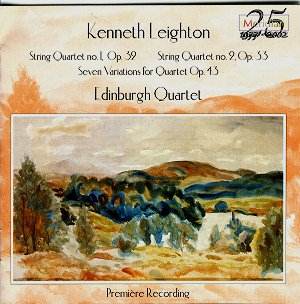Kenneth Leighton’s string quartets were composed almost
simultaneously in 1956 and 1957. They obviously share many characteristics,
but the most remarkable thing about them is that the composer succeeded
in writing two highly contrasted works. It goes without saying that
they both share Leighton’s contrapuntal mastery and ability to develop
long paragraphs from limited material, which the composer varies and
expands with remarkable assurance and sureness of touch. They also share
Leighton’s personal emotional world with their mix of sorrowful meditation
and powerful energy, of contrapuntal complexity and often deceptive
simplicity, of exacerbated chromaticism and almost easy-going diatonicism.
The String Quartet No.1 Op.32, a BBC
commission, was written for the Aeolian Quartet to celebrate the tenth
anniversary of the Third Programme (as it was then known). When fulfilling
this commission, the composer planned a second quartet that was, as
it were, written "alongside" the first quartet. Of the two,
the First String Quartet is the most traditional, i.e. as far as its
structure is concerned; for with Leighton, things are never quite that
simple. The first movement opens with a statement of the main material
by the viola. This is varied and expanded with a remarkable mastery
and imagination. The music gains momentum and reaches some carefully
placed climaxes before ending in quiet beauty. The central movement
is an extended aria in two parts, each ending with a climax. A brief
reference to the opening concludes the movement. This is followed by
a nervous Finale restating some material from the preceding movements.
The music moves along with much energy, pauses in some calmer sections
and finally reaches its robust, assertive conclusion.
The String Quartet No.2 Op.33 was completed
in 1957 and first performed by the New Edinburgh Quartet in October
of that year. As already mentioned, it is a somewhat more complex work
than its predecessor. It is in four movements of which the outer ones
are the most developed. The first movement moves from its Molto Adagio
opening to its Presto conclusion. It opens with a long slow introduction
presenting a theme that, in one way or another, dominates the entire
movement. The music unfolds to reach some intense climaxes before ending
with a quiet coda recalling the textures of the opening. There follows
a Marcia Lenta with an animated central section. The third movement
is an energetic Scherzo with some fugal sections. The Second String
Quartet ends with a long Epilogo which is one of Leighton’s finest
and most moving pieces of music. It is based on two contrasted ideas
:a heartfelt, tragic and highly chromatic theme; and a simpler, diatonic
Dolce e semplice. However, the conflict between these contrasting
themes is left unresolved, and the quartet ends, as it had begun, in
ambiguity.
The Seven Variations Op.43, commissioned
for the Arriaga Quartet by Maurice de Sausmarez in memory of his mother,
is a suite of seven mainly short, contrasting movements, in turn elegiac,
sorrowful and ironic, but the last variation Adagio e sostenuto
is the longest and the most emotionally charges of the set, carrying
"the main emotional weight of the work" (the composer’s words).
However, at the end, "all questions remain unanswered". The
Seven Variations Op.43, however, is no slight or lightweight
piece though it may be more readily accessible than the more substantial
and complex string quartets. Indeed, any composer less modest than Leighton,
would have called it a string quartet. While listening to this fine
work and to the two string quartets, one cannot but regret that Leighton
did not write more for string quartet, for this exacting but immensely
rewarding medium was remarkably suited to Leighton’s often introspective
music. These works, however, belong to the finest British string quartets
of the second half of the 20th Century, and are among his
finest achievements.
I have long known and loved these works from older
tapes of broadcast performances, and I have been waiting for this recording
for many long years. Now, here they are, in excellent performances and
fine recorded sound (a bit on the dry side at times), and with illuminating
notes by Edward Harper from which I have unashamedly quoted. A most
welcome addition to Leighton’s expanding discography, this wonderful
release is unreservedly recommended.
Hubert Culot


